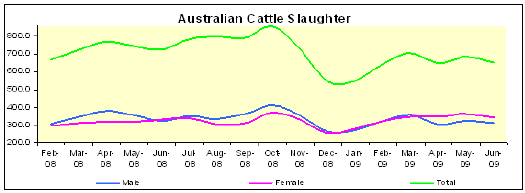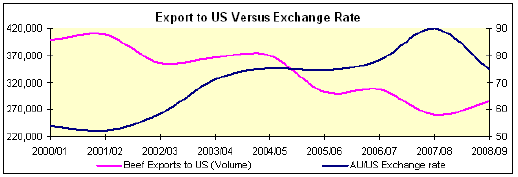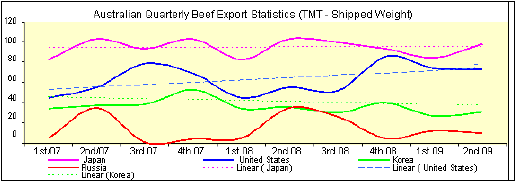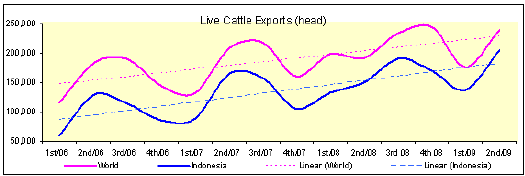



Australia - Livestock and Products Annual 2009
The Livestock and Products Annual report for Australia by the USDA Food and Agricultural Service (FAS) predicts that beef exports will fall in 2010 due to a fall in production and reduced export demand.Summary
Post forecasts beef slaughter and production to ease slightly in CY 2009 while remaining at historically high levels. Assuming average weather conditions, inventories are forecast to continue growing steadily and this should maintain a slight downward pressure on slaughter and production.
At the time of writing this report, the Australian continent is experiencing improved seasonal conditions following prolonged and severe drought which began in 2002. Despite improved conditions, the effects of such a severe drought continue to persist. Poor irrigation water availability together with historically low production levels of irrigated crops continue to somewhat constrain livestock production despite greatly improved pasture conditions.
Going forward, post’s forecasts are based upon the assumption that improved seasonal conditions, following years of drought, will see a return to herd rebuilding with producers retaining stock from slaughter for breeding purposes. Lower slaughter will see a slight reduction in production and exports in CY 2010 compared with the previous year. This trend is already underway in the second half of CY 2009 with some processing plants cutting shifts because of the reduced supply of slaughter cattle.
Numbers of cattle on feed continue to build steadily in CY 2009, following sharp declines in CY 2008. Lower grain prices have assisted feedlot placements greatly while an improved exchange rate appears to have partially buffered this sector from the current global financial crisis. However, these improvements have been somewhat constrained by shortages in cattle supply due to improved pasture conditions and continued shortages of certain feedstuffs. Going forward, feedlot numbers should continue to build for the remainder of CY 2009 and into CY 2010 as grain inventories also continue to build. Post advises that despite increased numbers of cattle on feed, current feedlot placements remain well below the levels achieved in CY 2006 and CY 2007.
Exports are forecast to ease in CY 2010 as a result of slightly lower production and reduced export market demand. Current industry reports have export demand down slightly but domestic consumption stronger. Recent gains in the Australian dollar has created concerns for exporters.
Changes in the valuation of the Australian dollar have a dramatic affect on exports of beef and veal and on imports of pig meat. Currently valued at US$.84, it is well below the high of US$0.97 reached during July 2008 and well above the US$0.62 recorded in December 2008 following the global financial crisis.
Production
Inventory
Inventory for CY 2010 is forecast to close at 28.46 million head, up two per cent on the closing inventory for the previous year. Improved pasture conditions and lower fodder prices are expected to see numbers increase slightly as producers withhold cattle from slaughter.
An inventory of 28.46 million cattle, if achieved, would be the highest since 1978. The record for cattle inventory remains the 32.67 million head reached in 1976.
Confidence in the cattle industry remains relatively high, despite the recent global financial crises. This confidence is reflected by relatively high prices currently received in cattle markets at time of writing this report.

Prices
Prices paid for live cattle are considered relatively firm. Reduced supply of cattle, due to herd rebuilding is primarily responsible for this. A steadily strengthening Australian dollar and subdued export demand continue to constrain price increases.
Prices paid for live cattle are expected to increase slightly in 2009/10 (July-June) as are prices received for beef exported to the US. Exports to Japan however are expected to suffer price reductions. Prices for live cattle are forecast by ABARE to remain above the ten-year average. However, if dry weather conditions are widespread, going forward would likely see cattle prices decline.

Slaughter
Post forecasts slaughter to decrease slightly in CY 2010 to 8.55 million head. This level remains below the ten-year average and signals a return to herd rebuilding following years of drought and high slaughter.
Post advises that lower slaughter remains contingent upon normal weather conditions allowing an increase in inventory. A return to drought conditions would likely increase slaughter beyond levels forecast by post.

Production
Production is forecast to decrease slightly in CY 2010 to 2,075 TMT. This forecast remains slightly below the ten-year-average and is constrained by lower slaughter due to improved seasonal conditions. Long running and severe drought, which began in CY 2002, previously pushed slaughter and production to record levels.
Carcase yield is expected to remain lower in CY 2010 as fewer adult cattle are slaughtered due to improved conditions. Should conditions deteriorate, this could increase and push production beyond current forecasts.
Some recent industry reports forecast production increasing slightly in 2010. Post believes that growth in slaughter and production will not likely allow for sufficient herd rebuilding.

Trade
Exports
Total beef exports for CY 2010 are forecast to fall to 1,350 TMT (Carcase Weight Equivalent), down on the revised estimate of 1,390 TMT for the previous year. Exports of this level would roughly equate to 929 TMT in shipped weight, using a conversion factor of 1.4. Post’s forecast, if achieved, would be considered only slightly above average according to ABARE’s historical data.

Post anticipates that slightly lower production and continued strong domestic demand is likely to see exports fall slightly in CY 2010. The Australian dollar, which suffered a sharp decline in CY 2008, has been steadily increasing throughout CY 2009. At time of writing this report, the Australian dollar was valued at US$0.84, slightly above the ten year average but well below the level of year previous.

Export Markets
Slightly lower production and slightly stronger domestic demand in CY 2010 is expected to reduce the availability of beef suitable for export. A steadily appreciating Australian dollar, at time of writing this report, will also likely constrain exports going forward.
Exports to the US have rebounded in CY 2009 due to a sharply devalued Australian dollar. Post anticipates exports to this market to remain strong again in CY 2010, despite a steady increase in the Australian dollar value more recently as US consumers purchase more hamburgers. Post advises that the US market perhaps offers the best prospect for increased exports despite the anticipated fall in exportable surplus. Industry sources advise that an assumed increase in US exports going forward may provide greater opportunities for Australian beef in the US.
Exports to Japan have held relatively firm in CY 2009 despite difficult trading conditions. Improved supplies of grain-fed beef together with less demand competition from other export markets such as Korea have combined to see exports to this market fall only slightly, despite sluggish demand.
Exports to Korea on a quarterly basis have remained at relatively low levels in CY 2009. Increased competition from US beef is expected to see Australian exports to Korea remain at modest levels.

Exports to Russia have fallen sharply in CY 2009. At its peak, Russia briefly surpassed Korea in CY 2008 to become Australia’s third largest export market. Industry reports suggest Russian importers continue to face credit problems and this, combined with some access issues are likely to persist well into CY 2010.
Cattle on feed
Total numbers of cattle on feed in Australia have continued to grow modestly through CY 2009 with numbers on feed remaining previous high levels. Despite reaching 744,000 in the 2009 June quarter, this level remains well below the record 940,000 head achieved in CY 2006.
Post anticipates numbers of cattle on feed to continue growing at modest levels during CY 2010. Improved feed grain supplies, which are responsible for increased placements, will be somewhat constrained by sluggish export demand and tight availability of suitable cattle.

Live cattle
Live cattle exports are forecast to increase only slightly in CY 2010. Shipments of cattle have increased substantially following low levels in CY 2006. Strong growth in CY 2008 and CY 2009 has been driven by increased demand from Indonesia and increased cattle availability due to dry conditions in northern Australia.
Improved seasonal conditions and the associated lower supply of cattle are expected to constrain growth in live cattle exports going forward. Post anticipates total cattle exports to increase only slightly in CY 2010.
Policy:
US beef has been denied access to the Australian market since the detection of BSE in the US, despite the efforts by US Government representatives to have the market opened. Australian industry sources have made representation to senior Australian government figures asking for the Australian market to be reopened to US beef due to concerns regarding fair treatment a future Australian beef exports. Post will continue to aggressively push for the removal of this non-tariff trade barrier.

Further Reading
| - | You can view the full report by clicking here. |
January 2010


